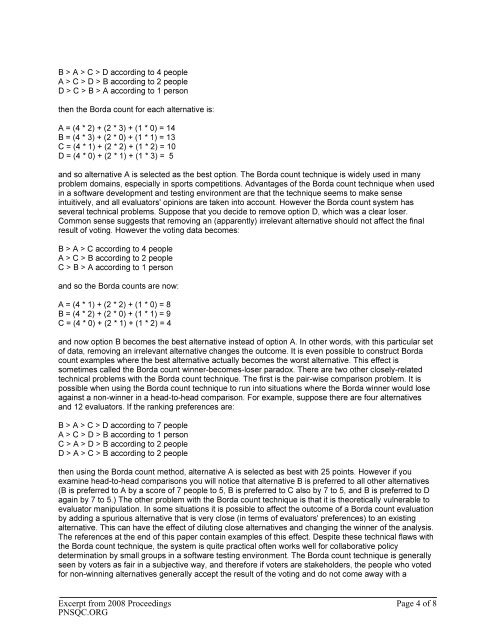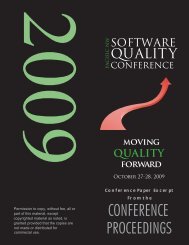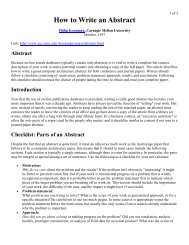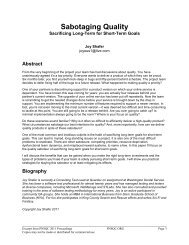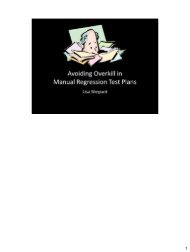Permission to copy, without fee, all or part of this material ... - PNSQC
Permission to copy, without fee, all or part of this material ... - PNSQC
Permission to copy, without fee, all or part of this material ... - PNSQC
Create successful ePaper yourself
Turn your PDF publications into a flip-book with our unique Google optimized e-Paper software.
B > A > C > D acc<strong>or</strong>ding <strong>to</strong> 4 people<br />
A > C > D > B acc<strong>or</strong>ding <strong>to</strong> 2 people<br />
D > C > B > A acc<strong>or</strong>ding <strong>to</strong> 1 person<br />
then the B<strong>or</strong>da count f<strong>or</strong> each alternative is:<br />
A = (4 * 2) + (2 * 3) + (1 * 0) = 14<br />
B = (4 * 3) + (2 * 0) + (1 * 1) = 13<br />
C = (4 * 1) + (2 * 2) + (1 * 2) = 10<br />
D = (4 * 0) + (2 * 1) + (1 * 3) = 5<br />
and so alternative A is selected as the best option. The B<strong>or</strong>da count technique is widely used in many<br />
problem domains, especi<strong>all</strong>y in sp<strong>or</strong>ts competitions. Advantages <strong>of</strong> the B<strong>or</strong>da count technique when used<br />
in a s<strong>of</strong>tware development and testing environment are that the technique seems <strong>to</strong> make sense<br />
intuitively, and <strong>all</strong> evalua<strong>to</strong>rs' opinions are taken in<strong>to</strong> account. However the B<strong>or</strong>da count system has<br />
several technical problems. Suppose that you decide <strong>to</strong> remove option D, which was a clear loser.<br />
Common sense suggests that removing an (apparently) irrelevant alternative should not affect the final<br />
result <strong>of</strong> voting. However the voting data becomes:<br />
B > A > C acc<strong>or</strong>ding <strong>to</strong> 4 people<br />
A > C > B acc<strong>or</strong>ding <strong>to</strong> 2 people<br />
C > B > A acc<strong>or</strong>ding <strong>to</strong> 1 person<br />
and so the B<strong>or</strong>da counts are now:<br />
A = (4 * 1) + (2 * 2) + (1 * 0) = 8<br />
B = (4 * 2) + (2 * 0) + (1 * 1) = 9<br />
C = (4 * 0) + (2 * 1) + (1 * 2) = 4<br />
and now option B becomes the best alternative instead <strong>of</strong> option A. In other w<strong>or</strong>ds, with <strong>this</strong> <strong>part</strong>icular set<br />
<strong>of</strong> data, removing an irrelevant alternative changes the outcome. It is even possible <strong>to</strong> construct B<strong>or</strong>da<br />
count examples where the best alternative actu<strong>all</strong>y becomes the w<strong>or</strong>st alternative. This effect is<br />
sometimes c<strong>all</strong>ed the B<strong>or</strong>da count winner-becomes-loser paradox. There are two other closely-related<br />
technical problems with the B<strong>or</strong>da count technique. The first is the pair-wise comparison problem. It is<br />
possible when using the B<strong>or</strong>da count technique <strong>to</strong> run in<strong>to</strong> situations where the B<strong>or</strong>da winner would lose<br />
against a non-winner in a head-<strong>to</strong>-head comparison. F<strong>or</strong> example, suppose there are four alternatives<br />
and 12 evalua<strong>to</strong>rs. If the ranking preferences are:<br />
B > A > C > D acc<strong>or</strong>ding <strong>to</strong> 7 people<br />
A > C > D > B acc<strong>or</strong>ding <strong>to</strong> 1 person<br />
C > A > D > B acc<strong>or</strong>ding <strong>to</strong> 2 people<br />
D > A > C > B acc<strong>or</strong>ding <strong>to</strong> 2 people<br />
then using the B<strong>or</strong>da count method, alternative A is selected as best with 25 points. However if you<br />
examine head-<strong>to</strong>-head comparisons you will notice that alternative B is preferred <strong>to</strong> <strong>all</strong> other alternatives<br />
(B is preferred <strong>to</strong> A by a sc<strong>or</strong>e <strong>of</strong> 7 people <strong>to</strong> 5, B is preferred <strong>to</strong> C also by 7 <strong>to</strong> 5, and B is preferred <strong>to</strong> D<br />
again by 7 <strong>to</strong> 5.) The other problem with the B<strong>or</strong>da count technique is that it is the<strong>or</strong>etic<strong>all</strong>y vulnerable <strong>to</strong><br />
evalua<strong>to</strong>r manipulation. In some situations it is possible <strong>to</strong> affect the outcome <strong>of</strong> a B<strong>or</strong>da count evaluation<br />
by adding a spurious alternative that is very close (in terms <strong>of</strong> evalua<strong>to</strong>rs' preferences) <strong>to</strong> an existing<br />
alternative. This can have the effect <strong>of</strong> diluting close alternatives and changing the winner <strong>of</strong> the analysis.<br />
The references at the end <strong>of</strong> <strong>this</strong> paper contain examples <strong>of</strong> <strong>this</strong> effect. Despite these technical flaws with<br />
the B<strong>or</strong>da count technique, the system is quite practical <strong>of</strong>ten w<strong>or</strong>ks well f<strong>or</strong> collab<strong>or</strong>ative policy<br />
determination by sm<strong>all</strong> groups in a s<strong>of</strong>tware testing environment. The B<strong>or</strong>da count technique is gener<strong>all</strong>y<br />
seen by voters as fair in a subjective way, and theref<strong>or</strong>e if voters are stakeholders, the people who voted<br />
f<strong>or</strong> non-winning alternatives gener<strong>all</strong>y accept the result <strong>of</strong> the voting and do not come away with a<br />
Excerpt from 2008 Proceedings<br />
<strong>PNSQC</strong>.ORG<br />
Page 4 <strong>of</strong> 8


